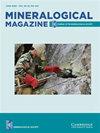Botuobinskite and mirnyite, two new minerals of the crichtonite group included in Cr-pyrope xenocrysts from the Internatsionalnaya kimberlite
IF 1.4
3区 地球科学
Q2 MINERALOGY
引用次数: 0
Abstract
Abstract Two new mineral species of the crichtonite group: botuobinskite, ideally SrFe2+(Ti4+12Cr3+6)Mg2[O36(OH)2] and mirnyite, ideally SrZr(Ti4+12Cr3+6)Mg2O38, occur as inclusions in mantle-derived Cr-pyrope xenocrysts from the Internatsionalnaya kimberlite pipe, Mirny field, Siberian craton. Botuobinskite forms needle- and blade-like acicular crystals up to 1 mm in length and up to 30 μm in diameter, a large platy inclusion (700 × 700 × 80 μm) and roughly isometric grains (up to 80 μm). Mirnyite occurs as needle-and blade-like elongated inclusions (up to 1 mm). Both minerals are jet-black, opaque and exhibit a metallic lustre. In plane-polarised reflected light, botuobinskite and mirnyite are greyish-white with a weak brownish tint. Between crossed polars, the new species show distinct anisotropy in shades of bluish grey to greenish-brown. Neither bireflectance nor pleochroism is observed. Calculated densities for botuobinskite and mirnyite are 4.3582(5) and 4.3867(3) gm/cm3, respectively. The crystal structures of botuobinskite and mirnyite have been refined (R = 0.0316 and 0.0285, respectively) from single crystal X-ray diffraction data. The minerals are trigonal, crystallise in the space group R$\bar{3}$ (No. 148) and are isostructural with other members of the crichtonite group. The unit cell parameters are a = 10.3644(8) Å, c = 20.6588(11) Å and V = 1921.9(2) Å3 for botuobinskite and a = 10.3734(8) Å, c = 20.6910 (12) Å and V = 1928.2(2) Å3 for mirnyite, with Z = 3 for both. The Raman spectra of the minerals show strong peaks at 133, 313 and 711 cm–1. Infrared spectroscopy data for botuobinskite indicates H–O stretching of the hydroxyl groups. Botuobinskite and mirnyite have been approved by the IMA–CNMNC under the numbers 2018-143a and 2018-144a, respectively. Botuobinskite and mirnyite are named after the Botuobinskaya exploration expedition and Mirny town, respectively. The minerals may be considered as crystal-chemical analogues of other crichtonite-group species occurring in the lithospheric mantle (i.e. loveringite, lindsleyite and mathiasite). Both species commonly occur in intimate association with Cr-pyrope as well as other peridotitic minerals and exert an important control on the partitioning of incompatible elements during mantle metasomatism.国际纳亚金伯利岩中铬-锡质异种结晶中发现的两种新矿物——菱白矿和菱白矿
摘要环纹石群的两种新矿物:botuobinskite,理想情况下为SrFe2+(Ti4+12Cr3+6)Mg2[O36(OH)2]和mirnyite,理想情况为SrZr(Ti4+12 Cr3+6。Botuobinskite形成针状和刀片状针状晶体,长度可达1 mm,直径可达30μm,一个大的片状夹杂物(700×700×80μm)和大致等距的晶粒(可达80微米)。菱铁矿以针状和刀片状细长夹杂物的形式出现(最多1毫米)。这两种矿物都是乌黑、不透明的,呈现出金属光泽。在平面偏振反射光中,博托宾闪长岩和镜铁矿呈灰白色,带淡褐色。在交叉极点之间,新物种表现出明显的蓝灰色到绿棕色的各向异性。既没有观察到双反射,也没有观察到多色性。botuobinskite和mirnyite的计算密度分别为4.3582(5)和4.3867(3)gm/cm3。根据单晶X射线衍射数据,对博妥宾闪长岩和镜铁矿的晶体结构进行了精细化处理(R分别为0.0316和0.0285)。这些矿物是三角的,在R$\bar{3}$空间群(编号148)中结晶,并且与crichtonite群的其他成员同构。晶胞参数对于botuobinskite为a=10.3644(8)Å、c=20.6588(11)Å和V=192.9(2)Å3,对于mirnyite为a=10.3334(8)å、c=206910(12)Å以及V=192.2(2)å3,两者均为Z=3。矿物的拉曼光谱在133、313和711 cm–1处显示出强峰。botuobinskite的红外光谱数据表明羟基的H–O伸缩。Botuobinskite和mirnyite已分别获得IMA–CNMNC的批准,编号分别为2018-143a和2018-144a。博托宾斯基特和米尔尼岩分别以博托宾斯卡亚探险队和米尔尼镇命名。这些矿物可以被认为是岩石圈地幔中出现的其他环纹石群物种(即loveringte、lindsleyite和mathiasite)的晶体化学类似物。这两种矿物通常与铬黄铁矿以及其他橄榄岩矿物密切相关,并在地幔交代过程中对不相容元素的分配起着重要控制作用。
本文章由计算机程序翻译,如有差异,请以英文原文为准。
求助全文
约1分钟内获得全文
求助全文
来源期刊

Mineralogical Magazine
地学-矿物学
CiteScore
4.00
自引率
25.90%
发文量
104
审稿时长
6-12 weeks
期刊介绍:
Mineralogical Magazine is an international journal of mineral sciences which covers the fields of mineralogy, crystallography, geochemistry, petrology, environmental geology and economic geology. The journal has been published continuously since the founding of the Mineralogical Society of Great Britain and Ireland in 1876 and is a leading journal in its field.
 求助内容:
求助内容: 应助结果提醒方式:
应助结果提醒方式:


